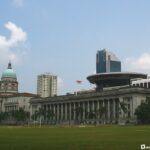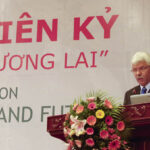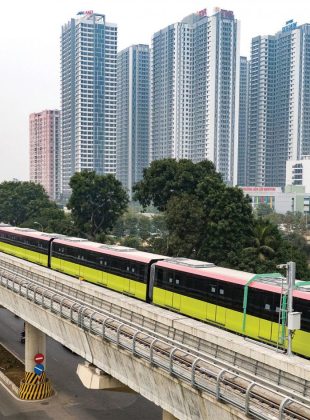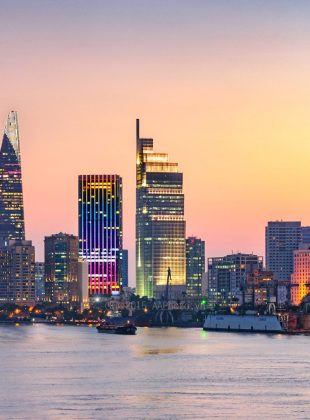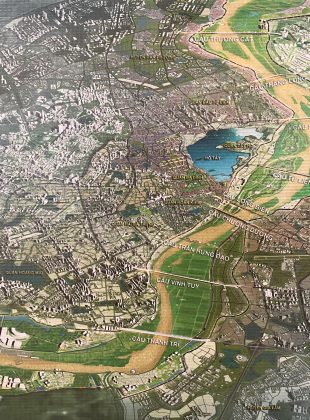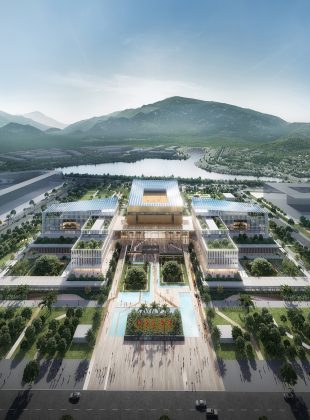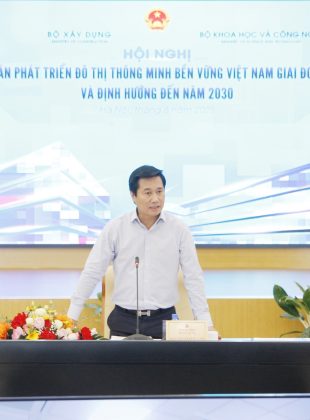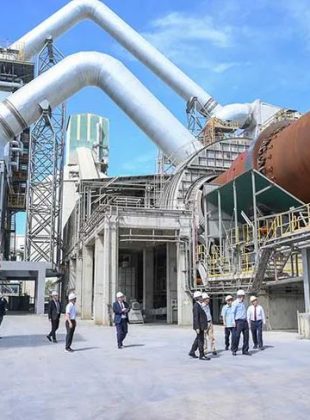[Tiếng Việt] UN-HABITAT was very proud to participate in the Hanoi Millennium Conference, celebrating 1000th year of the city’s cumulative history and development, on 12-13 October 2010. The coming together of many experts for the celebration of Hanoi Millennium was a very important initiative to look back at the past, take stock of Hanoi urbanization history and move forward with renewed vigor for the future.
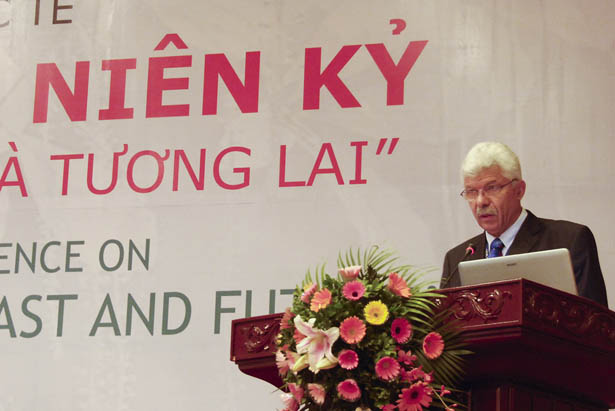
Mr. Daniel Biau – Director of Regional and Technical Cooperation Division (UN-Habitat) – at the conference on “Hanoi Millennium – City past and future”
1.INTRODUCTION
As we all know, Asia in its totality represents 60 percent of humankind. Moreover, Asian cities are home to nearly half the urban population of the world. The recently issued first State of Asian Cities Report 2010/11 shows that in 2010, the urbanization rate in the region stands at 42.2 per cent, and with its current rapid urban growth, Asia is expected to turn “urban”, with over 50 per cent of population living in cities, by the year 2025. Viet Nam itself is already 30.4% urban (27 million urban out of 89 million inhabitants) and will reach 50% before 2040. Along with these phenomenal demographic changes, the region is also experiencing unprecedented rates of economic growth – actually it has emerged as an economic power-house in the world, and has been successful in dealing with the painful blows of the global economic recession since 2008. The State of Asian Cities Report 2010 also shows that as high as 80 per cent of the economic growth in the region is led by cities and towns. I have come frequently to Asia since 1975 and have witnessed this evolution with my own eyes.
The region is going through major reforms and introducing remarkable innovations in financing, service delivery, management and technology relating to housing and urban development. Yet, this is also a region still confronting the challenges of poverty, slum settlements, urban environmental pollution, and climate change including the increasing number and severity of natural disasters. The State of Asian Cities Report 2010 underlines that 240 million people live in the coastal areas below 10 metres elevation in Asia.
The challenges of housing and urban development, in their broad sense, are critically linked to both the positive dynamics that are evolving in the region, and the dysfunctional shortcomings that are still widespread.
The themes that were considered at the Conference have a bearing beyond the specific sectors of housing and urban development. They are linked primarily to the quality of life of the Vietnamese people. That is the bottom line. To meet that goal, we had to re-examine the role of government, communities and civil society in planning and governance, to discuss how slums can be upgraded involving local communities, the progress made on MDG on water and sanitation in the region, the manner in which financing, both public and private, is and can be mobilized for housing and urban development, and in what ways local communities can contribute to addressing climate change impacts.
International exchanges, sharing of experiences and identification of areas of progress should lead to concrete efforts in order to make a difference in the living conditions of Hanoi citizens.
I will address in a fist part the common challenges of Asian cities, then the specific challenges of Hanoi and I will conclude on a demographic overview of the Asian urbanisation process.
2. ASIA URBANISATION CHALLENGES
From the start, I wish to submit five issues for the consideration of the readers. They refer to problems that are shared by almost all Asian countries.
The first issue is about harnessing community participation in planning and governance. Asian countries have made substantial progress in terms of decentralization. A result of this process has been the empowerment of communities and civil society organizations to be part of formal systems of participation in governance. Direct community participation has mainly benefited programme and project implementation – this in turn has generated a wealth of knowledge. However in many countries, master planning seems still to hold sway, limiting the decision-making to a group of professionals, often preventing meaningful community participation in planning and governance. Some questions to reflect are the following: What role can community-based and civil society organizations play in both urban planning and municipal governance? How can we best utilize the knowledge already gained for improving the urban development process? How can we enhance the capacity of planning agencies for better planning and management? It is necessary to share experiences on stakeholder participation in different levels of planning and governance.
The second and related issue is about participatory urban upgrading, a key focus area for UN-HABITAT. Despite the national governments’ efforts and achievements in slum upgrading, the Asia-Pacific region still accounts for about 50 per cent of the world’s slum dwellers. Experience from many countries in the region shows that slum dwellers contribute to urban upgrading as well as informal sector development when they are systematically involved in this process. Various national and local governments, regional agencies as well as UN-HABITAT have been working on this issue, and this cumulative learning has led to the development of what has come to be known as the “People’s Process of Development”, a tried and tested approach that includes community organization, community action planning, community contracting, community saving and credit, and community monitoring. While local governments are best placed for proper urban planning, the strengths, resources and skills of the local communities need to be harnessed for slum upgrading, moving from project-based interventions to citywide up-scaling. How to support participatory development of informal sector including micro-enterprises? How to strengthen the role of women and community-based organizations in slum upgrading? How to promote people-based and community-based policies and programmes? How to enable the upgrading of informal settlements with an emphasis on the People’s Process and citywide approaches? Which financing approaches for slum upgrading have worked for the low-income groups, and how to build capacity of major actors? How to develop a comprehensive land and housing policy? Urban upgrading is a huge challenge for the region. Therefore successes and difficulties must be discussed at the regional level in order to address this challenge systematically.
The third issue is about the delivery of the MDGs for water and sanitation. As we have said on several occasions ‘water is life, sanitation is dignity”. The good news is that most countries in Asia are on track to meet the MDG target on safe drinking water. But the bad news is that sanitation remains a major challenge as 1.9 billion people in the region still lack access to improved sanitation. In addition, the absolute number of people in urban areas without improved sanitation is increasing, which calls for community-based and locally-suited sanitation solutions. What are the good experiences in planning for water supply systems, and collection and treatment of wastewater? What can we do to optimize management of water and wastewater systems and reform the public sector? Which financing approaches for resource mobilisation for expanding water and wastewater infrastructure have worked? How can we enhance the role of local communities in water and wastewater management at the neighbourhood-level? We should learn from the experiences of other cities to meet the MDG targets on water and sanitation here in Hanoi.
The fourth issue is about resources, financial resources for both sustainable housing and urban development. Investment in housing and urban infrastructure is not keeping pace with the growing needs in the Asia-Pacific region. The demand for housing and developed land far exceeds their supply in the fast growing Asia-Pacific cities. And we all know about problem of “rich cities and poor local governments”, which hints toward the need for further decentralization of powers for cities to mobilise financial resources. While a number of Asian countries have seriously developed their housing finance systems in recent years, other countries have focused on supporting microfinance institutions. Land is a potential resource, and unlocking its monetary value is an excellent source for capital for urban development. Whilst there are lessons being learnt from the global economic recession, how do we create better understanding of urban land dynamics for the development of urban land markets in Viet Nam? How can national and local governments facilitate access to financial resources for middle- and low-income housing? What are the financing instruments available for urban development, including infrastructure? How to better utilize public-private partnership for urban development? This is a very difficult challenge on which we need more information and analysis on what works and what does not work.
Finally, the last issue is about the role of various actors in addressing climate change. Climate change will have a significant impact on the future urban development in the Asia region. It is well known that coastal cities will be affected not only by sea-level rise, but also from extreme climate events, such as floods and storms. Small island nations, such as the Pacific Islands, Maldives or Sri Lanka have specific needs related to climate change adaptation. The experience from the Asia-Pacific region shows a wide range of climate change adaptation measures are already being applied. We need to clearly understand what role local communities play in building climate and disaster resilient human settlements related to their planning and development, and design and retrofitting of infrastructure. How can we strengthen the role of communities in addressing climate change impacts, building on their assets, skills and traditional knowledge? There is a need to strengthen community preparedness, through improved education, training and public culture, in order to build climate resilient communities. Where to start? How to upscale? The region has rich experience in post-disaster reconstruction – how to mainstream community-led reconstruction approaches, such as the People’s Process, in the face of climate change impacts including the increasing number of floods. Again we need to encourage the sharing of good practices in this area.
3. HANOI SPECIFIC CHALLENGES
For ten centuries, the history of Hanoi has been connected to its urbanization process. The citadel, ancient quarter and French colonial quarter are seen as the core or centre of the historical, cultural and administrative city. The city counted 50,000 inhabitants in 1902 when it became the capital of colonial Indochina and 800.000 inhabitants in 1975 at the end of the liberation war. Since the economic reform in 1986, the city population grew substantially at an annual rate of 3% and reached 2.8 million in 2010 according to the latest UN World Urbanization Prospects. The expansion of the administrative boundary in 2008 has doubled the population of the city-region to 6.4 million. However urban Hanoi is only ranked 62nd among Asian cities in term of population, it is not that big and will continue to grow in the next decades.
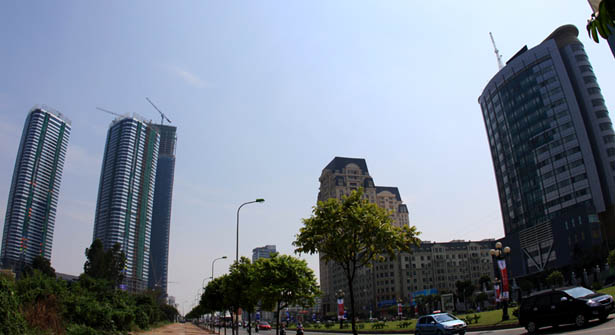
The introduction of the Doi Moi policy in 1989 was a significant turning point into considerable transformation of Hanoi. With an economic growth rate of about 10% annually, the GDP of Hanoi increased 11.2 times in the period of 1985-2000 and the current GDP per capita of the city has reached US$ 1,700. The city’s poverty rate sharply decreased from 62.7% in 1993 to 16.1% 2005 and the target of 5% poverty rate has been set for the current year.
The remarkable increase of FDI in Hanoi and its region, the emerging role of the local non-state economic sector and the liberalization of trade and services have contributed to changes in the city’s configuration. There have been profound transformations in housing production and distribution, with a boost of self built housing and appearance of a number of new urban areas. In 2009 only, the total newly constructed housing areas covered 2.3 sq.km. Development projects funded by donors have significantly improved urban infrastructure and basic services such as road networks, water supply, sewerage, sanitation. The proportion of the budget expenditure for social welfare in education, health care and social insurance has also increased markedly.
However, despite these achievements, Hanoi is facing difficulties from the combined impacts of increasing urban population, motorization, overloaded infrastructure and public service system, degradation of the environment, constantly growing and globalizing economy, which may threaten its sustainable development in different respects:
Economic development: The city has experienced rapid economic growth with unqualified manpower and low valued products. According to recent surveys inequality and income disparity are widening among various parts of the city.
Social development: There is a shortage in housing supply with new housing development projects targeting mainly high-income groups. Urban infrastructure systems and public service delivery are poor and insufficient, including the overload of transportation and drainage system as well as health and education facilities.
Environment: Environmental pollution and degradation have become serious due to uncontrolled urbanization, rapid motorization and intensive resource exploitation. Poor public transport systems have negative social and environmental consequences.
Urban Planning: So far urban planning cannot keep up with urban expansion. Urban architecture and cultural heritage are not enough considered, resulting in destruction and loss of important heritage and traditional buildings, including the deterioration of the world famous Long Bien bridge. Insufficient land-use planning provides unfortunate opportunities for speculation.
Local Governance: Appraisal of public investment programmes has not been based on a set of criteria taking into account the economic, social, financial and environmental implications. There is lack of mechanisms to mobilize funding for urban development. In addition, there is limited skills, knowledge and awareness of urban management among local agencies, especially at district and ward levels. Coordination among public institutions remains problematic in many respects.
As we celebrate Hanoi’s 1000 year anniversary, we laud your effort to complete the preparation of the Master Plan for Hanoi capital to 2030 with vision toward 2050. This long-term exercise is critical so you can plan and manage the changes that happen in this beautiful city.
The greatest challenge is to define a vision of sustainable and inclusive development whereby Hanoi becomes a positive reality for everyone, not just for urban planners and managers. As urbanization is to continue, in the future Hanoi should function more effectively as the capital of the country and the engine for regional and national development. The significant challenges that the Plan should address include:
• to improve competitiveness not only nationwide but also in the region (Hanoi 2009 provincial competitive index is pretty low – ranked 33 among 63 cities and provinces),
• to promote development on the other bank of the Red River and along the Hanoi-Haiphong corridor,
• to increase the provision of affordable housing for the population of a region of about 10 million people by 2030,
• to deliver urban infrastructure and services including well-functioning transportation system, water supply, sanitation, drainage, solid waste collection and treatment, education and health care,
• to mitigate the impacts of climate-related disasters, particularly on the urban poor and the vulnerable groups, and to implement appropriate adaptation strategies.
Hanoi’s planners have to find a fair balance between economic growth and competitiveness of the city on the one hand, and the protection of its natural wealth and built environment on the other. This is a difficult but stimulating task.
4. STATISTICAL BACKGROUND
I would like to bring to the attention of policy-makers a few figures derived from the already quoted “World Urbanization Prospects: The 2009 Revision”. They are the only official statistics on urbanization, compiled and updated by our colleagues of the UN Population Division in collaboration with all Statistical Bureaus of the world. I have made a synthesis in a few tables which show the magnitude of the urbanization process in the region as well as the forecast until 2050. As demonstrated in the State of the World’s Cities Reports, urbanization is a positive and progressive phenomenon which encompasses challenges and opportunities. The role of policy-makers is to address the challenges and to take advantage of the opportunities. For that purpose they need to be fully aware of the state of their cities and towns, both qualitatively and quantitatively. I believe therefore that the following figures could provide a useful background information to those in charge of planning for Hanoi future development.
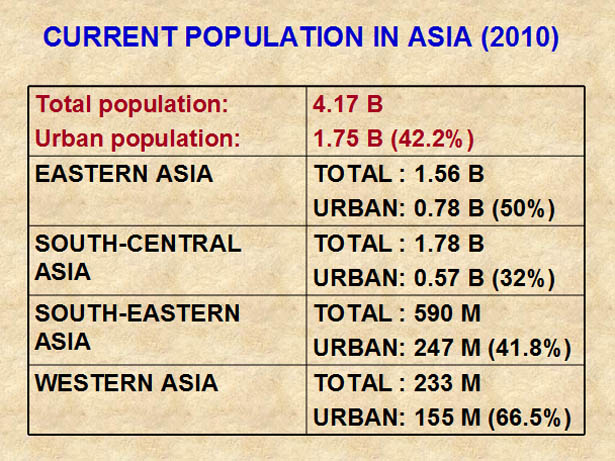
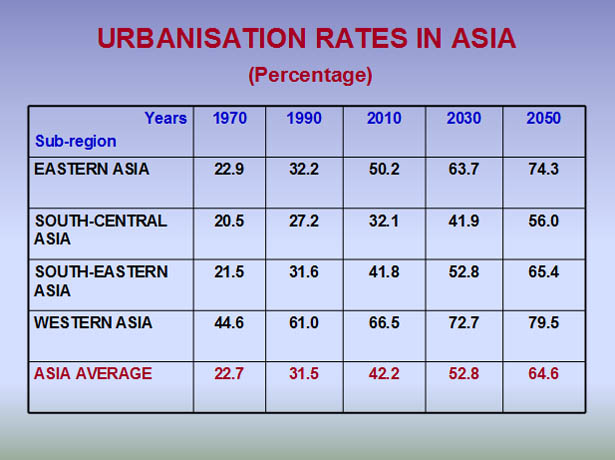
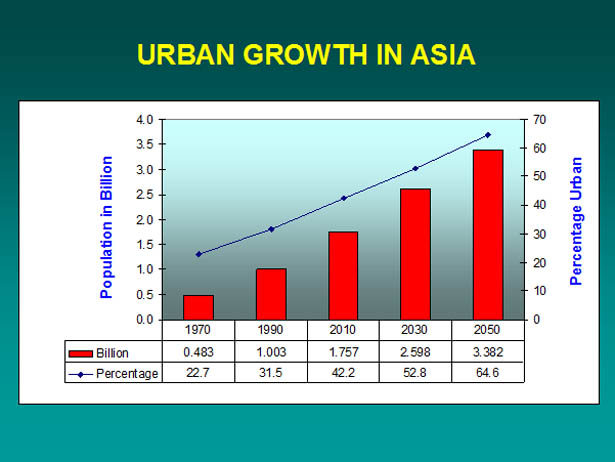
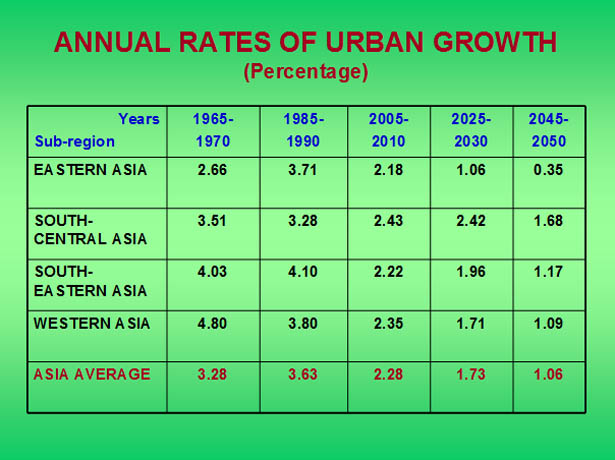
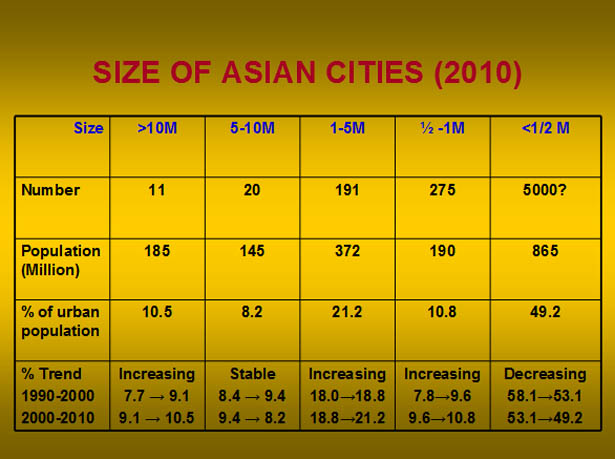
In view of these urban growth figures, the Conference on Hanoi Millennium was very timely. At UN-HABITAT, we are currently implementing a Medium-Term Strategic and Institutional Plan whose over-arching goal is to promote sustainable urbanization and we are launching an ambitious World Urban Campaign which will be lead by our new Executive Director, Mr. Joan Clos. Our vision is to see change on the ground –in the well-being of the people of all cities and towns, in the way the critical facets of land, housing, livelihoods and services are procured and accessed. The history of Hanoi is rich and its recent experience is stimulating, not only for South-East Asia but for the entire developing world.
As a UN body we are committed to work with Governments in building the necessary institutional capacities at all levels. Governments have to respond to climate change, floods and other disasters, to reduce poverty and inequality and to improve the living environment now and for the future generations. The deliberations at the Hanoi conference have helped the authorities in Viet Nam in charting out a viable path for such a shared ambition.
Daniel Biau, Director of Regional and Technical Cooperation Division (UN-Habitat)
![]()
>>


